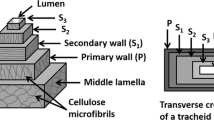Abstract
The stress-strain curves for pineapple leaf fibre have been analysed. Ultimate tensile strength (UTS), initial modulus (YM), average modulus (AM) and elongation of fibres have been calculated as functions of fibre diameter test length and test speed. UTS, YM, and elongation lie in the range of 362 to 748 MN m−2, 25 to 36 GN m−2, and 2.0 to 2.8%, respectively for fibres of diameters ranging from 45 to 205μm. UTS Was found to decrease with increasing test lengths in the range 15 to 65 mm. Various mechanical parameters show marginal changes with change in speed of testing in the range of 1 to 50 mm min−1. The above results are explained on the basis of structural variables of the fibre. Scanning electron microscope studies of the fibres reveal that the failure of the fibres is mainly due to large defect content of the fibre bo1h along the fibre and through the cross-section, The crack is always initiated by the defective cells and further aggravated by the weak bonding material between the cells.
Similar content being viewed by others
References
“Report on Pineapple Fibres” (Khadi and Village Industries Commission, Bombay, India, 1980).
K. G. Satyanarayana, A. G. Kulkarni andP. K. Rohatgi,J. Sci. Ind. Res. (India) 40 (1981) 222.
M. K. Sinha, Paper presented at the All India Seminar on Fibre Industry, Trivandrum, March 1981 (available from the author).
R. H. Kirby, “Vegetable Fibres” (Hill, London, 1963), p. 312.
C. U. Cauto, M. S. Palmario, Z. S. Imperial, A. S. Tayco, R. P. Sariaga, R. V. Bunnaventura andM. C. De Guzinan, paper presented at NSOB Project Evaluation Series held at P.J. Gracis Memorial Hall, Manila, Philippines, August 1976.
M. R. Mauesberger (editor), “Textile Fibres”, 6th Edn (Wiley, New York, 1954).
S. K. Kallapur, “Bark and Leaf Fibres of India” (Directorate of publicity, Khadi and Village Industries Commission, Bombay, 1962).
Kalyani Vijayan, Technical Brief No. MT-TB-1-80 (National Aeronautical Laboratory, Bangalore, 1980).
H. P. Stout andJ. A. Jenkins,Ann. Sci. Text. Belges N 4-12/56 (1955) 281.
Annual Report, Jute Technological Research Laboratory, Calcutta (1978) p. 14.
Annual Report, Jute Technological Research Laboratory, Calcutta (1979) p. 12.
Philippines Textiles Research Institute, Manila, private communication (1979).
P. S. Mukherjee andK. G. Satyanarayana,J. Mater. Sci. 19 (1984) 3925.
A. G. Kulkarni, K. G. Satyanarayana, P. K. Rohatgi andKalyani Vijayan,ibid. 18 (1982) 2790.
A. G. Kulkarni, K. G. Satyanarayana andP. K. Rohatgi,ibid 16 (1981) 905.
E. C. McLaughlin andR. C. Tait,ibid. 15 (1980) 89.
J. M. G. Cowie, “Polymers: Chemistry and Physics of Modern Materials” (Intertext Books, Aylesbury, Buckinghamshire, UK) p. 228.
Author information
Authors and Affiliations
Rights and permissions
About this article
Cite this article
Mukherjee, P.S., Satyanarayana, K.G. Structure and properties of some vegetable fibres. J Mater Sci 21, 51–56 (1986). https://doi.org/10.1007/BF01144698
Received:
Accepted:
Issue Date:
DOI: https://doi.org/10.1007/BF01144698




